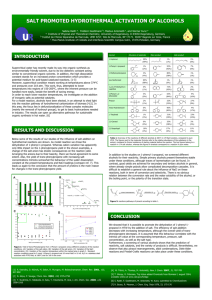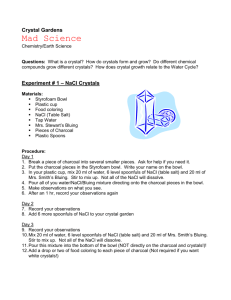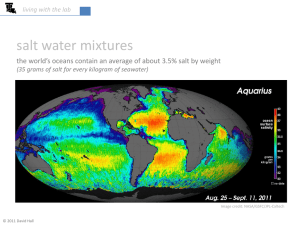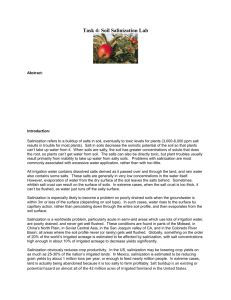conservation of mass
advertisement
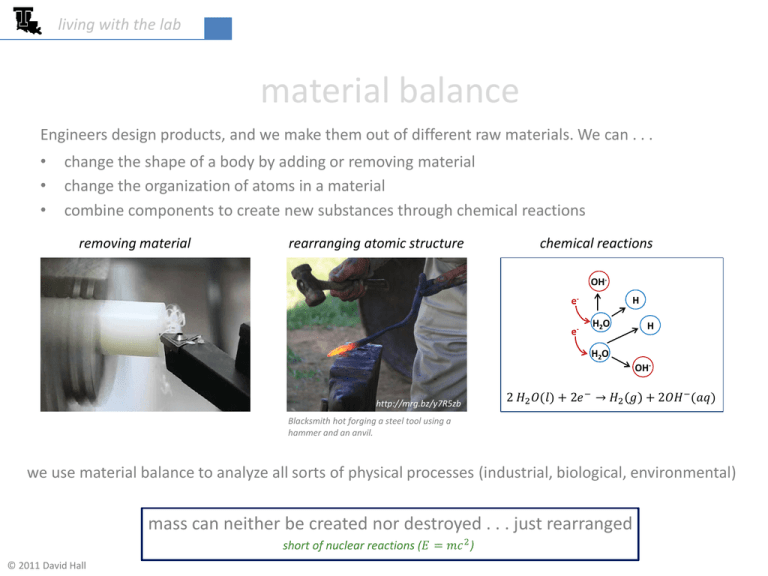
living with the lab material balance Engineers design products, and we make them out of different raw materials. We can . . . • • • change the shape of a body by adding or removing material change the organization of atoms in a material combine components to create new substances through chemical reactions removing material rearranging atomic structure chemical reactions OHee- H H2O H H2O OHhttp://mrg.bz/y7R5zb 2 𝐻2 𝑂(𝑙) + 2𝑒 − → 𝐻2 𝑔 + 2𝑂𝐻 − (𝑎𝑞) Blacksmith hot forging a steel tool using a hammer and an anvil. we use material balance to analyze all sorts of physical processes (industrial, biological, environmental) mass can neither be created nor destroyed . . . just rearranged short of nuclear reactions (𝐸 = 𝑚𝑐 2 ) © 2011 David Hall living with the lab material balance . . . keeping track of the mass 𝑚𝑖𝑛 𝑚𝑖𝑛 − 𝑚𝑜𝑢𝑡 + 𝑚𝑔𝑒𝑛𝑒𝑟𝑎𝑡𝑒𝑑 − 𝑚𝑐𝑜𝑛𝑠𝑢𝑚𝑒𝑑 = ∆𝑚𝑠𝑦𝑠𝑡𝑒𝑚 accumulation of mass in the system 𝑚𝑜𝑢𝑡 if chemical reactions occur, new system components may be generated . . . while others are consumed 2 𝐻2 𝑂(𝑙) + 2𝑒 − → 𝐻2 𝑔 + 2𝑂𝐻 − (𝑎𝑞) 2 living with the lab 𝑚𝑖𝑛 − 𝑚𝑜𝑢𝑡 = ∆𝑚𝑠𝑦𝑠𝑡𝑒𝑚 example applications • water in a lake water-flowingin + rain – water-flowingout - evaporation ≈ ∆ water mass • laundry dryer wet-laundryin – partially-dry-laundryout - evaporation = 0 • fishtank project NaCl initially in system + NaCl added - NaCl leaving through overflow = ∆ NaCl 3 Lake Hope, Ohio living with the lab batch & rate problems BATCH - start with nothing in system & end with nothing in system • • http://mrg.bz/UWUXAC making a batch of homemade ice cream mixing a batch of concrete in a mixer RATE – continuous flow of inputs and outputs 1. steady state – the amount or type of mass in the system does not change with time • a lake at a constant level water flowing in + rain – water flowing out – evaporation ≈ 0 2. non steady state – the amount or type of mass in the system changes with time • • a lake filling up with water water flowing in + rain – water flowing out – evaporation ≈ ∆ water mass a glacier whose mass is changing http://mrg.bz/zoeJry 4 living with the lab Class Problem A 10-gallon aquarium contains 2% salt by weight. How much salt would you need to add to bring the salt concentration to 3.5% salt by weight? 1. Draw a diagram to represent the system 2. Label all inputs and outputs, assigning variables to unknowns 𝑋 lbs dry salt 10 gal salt water 2% NaCl 98% H2O 𝑌 lbs salt water 3.5% NaCl 96.5% H2O 3. Apply conservation of mass to each component (salt & water) and for mixture first convert the water volume to weight: 𝑊𝐻2 𝑂 = 10𝑔𝑎𝑙 ∙ 0.1337𝑓𝑡 3 𝑙𝑏 ∙ 62.3 3 = 83.3 𝑙𝑏 𝑔𝑎𝑙 𝑓𝑡 http://mrg.bz/0hMAvl 5 living with the lab 3. Apply conservation of mass to each component (salt & water) and for mixture 𝑋 lbs dry salt 83.3 lb 10 gal salt water 2% NaCl 98% H2O overall: 𝑚𝑖𝑛 = 𝑚𝑜𝑢𝑡 𝑌 lbs salt water 3.5% NaCl 96.5% H2O salt: 𝑚𝑖𝑛 = 𝑚𝑜𝑢𝑡 water: 𝑚𝑖𝑛 = 𝑚𝑜𝑢𝑡 83.3 𝑙𝑏 + 𝑋 = 𝑌 0.02(83.3 𝑙𝑏) + 𝑋 = 0.035 ∙ 𝑌 (1) (2) 0.98 83.3 𝑙𝑏 = 0.965 ∙ 𝑌 (3) 4. Solve for the unknowns (you can use any of the three equations above) From (3): 𝑌 = 0.98 (83.3 𝑙𝑏) = 84.6 𝑙𝑏 0.965 Plug this into (1): 𝑋 = 𝑌 − 83.3 𝑙𝑏 = 84.6 𝑙𝑏 − 83.3 𝑙𝑏 = 1.29 𝑙𝑏 dry salt to add Is equation (2) useful??? why?? use it to check your work 6 living with the lab problem solving tips 1. Draw a picture of the system. Sometimes it’s not easy to determine the boundaries of your system. (a large river flowing into the ocean for example . . . where does river end and ocean begin?) 2. Label all inputs and outputs, listing all known quantities & concentrations and assigning variables to the unknowns. This key step is where errors usually occur. 3. Think about the problem a little bit . . . determine if the process is a rate or batch problem. Are components generated or consumed? Revise (1) and (2) if needed. 4. Write conservation of mass (or weight) for each component and for the entire system. Modify the diagram as new information is uncovered. 5. Solve for the unknowns. 6. Reflect on your solution. Do the concentrations or quantities make sense? WARNING avoid trying to just solve these problems in your head . . . use the systematic approach above 7




